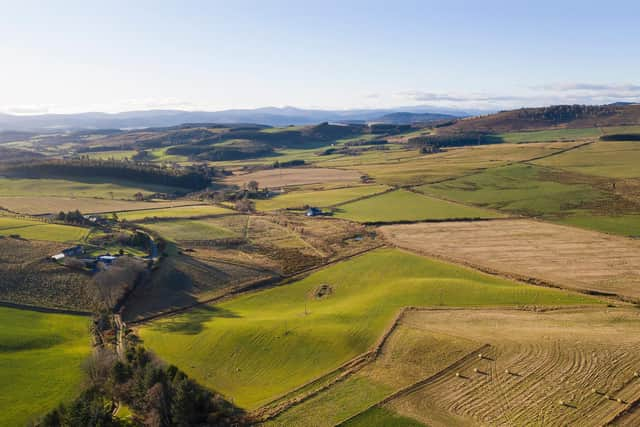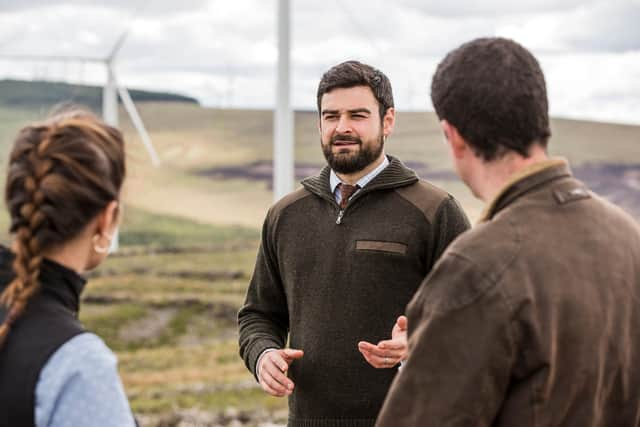Green push to plant trees and restore peatlands drives soaring land prices in Scotland
Sites with 'natural capital' potential are attracting huge interest from environmental buyers and fetching as much as 40 per cent over the asking price.
The value of land planted with commercial forestry has been rising steadily over the past five years, but now demand for rougher hill ground, traditionally considered to have limited uses, has risen significantly.
Advertisement
Hide AdAdvertisement
Hide AdAnd buyers are willing to pay a premium to get their hands on it.
One recent “stand-out” example was a 72-hectare agricultural property with a mix of permanent pasture and rough grazing in Aberdeenshire, which was advertised for sale at offers over £875,000.
It attracted multiple offers, sold very quickly and fetched way above the guide price – changing hands for almost £1.2 million.
Property experts say aspirations to plant trees – both productive forestry and native woodlands – are one of the key factors driving the trend and attracting new entrants to the market.
Carbon markets, which convert and monetise ecosystem services into recognised carbon credits, are also providing incentives.


But consultants at real estate firm Bidwells believe investors are looking for more than just financial returns from land and seeking “responsible projects” – things they are proud to put their names to, that will help tackle the twin crises of climate change and loss of wildlife species.
It is thought new appreciation of the countryside and nature, brought about during Covid-19 lockdowns, has also contributed.
Andy Turnbull, partner and head of natural capital and sustainable investment at Bidwells, said: “Over the past handful of years and particularly in the past 12 months, we have observed a rapid acceleration of interest and recognition of how our economies, livelihoods and well-being are dependent on our natural capital.


Advertisement
Hide AdAdvertisement
Hide Ad“It has perhaps been the global upheaval caused by the pandemic that has provided the wake-up call.
“In the so-called Age of Technology, Covid has reminded us that we are biological beings and we are part of nature and rely on it.”
Healthy forests and soils are natural sinks for carbon emissions, helping to combat climate change.
Conversely, when in degraded condition they can actually release carbon and add to global warming.
Around 85 per cent of agricultural land in Scotland is designated as Less Favoured Area.
Upland hill farming remains an important activity on such land, but evidence shows productive forestry is more lucrative – and has the added bonus of absorbing and locking up carbon.
National agency Forestry and Land Scotland (FLS) earlier this week announced a new acquisition strategy for buying land that can be used to help curb climate change.
The strategy is underpinned by a Scottish Government investment of £30m into a Low Carbon Investment Fund and the transfer of £9m of residual funds from the old woodland creation programme into a new Strategic Acquisition Fund.
Advertisement
Hide AdAdvertisement
Hide AdThe new strategy will allow FLS to purchase land for plant commercial conifers or native woodlands, sites suitable for peatland restoration and areas that will enhance natural capital and other environmental benefits.
But there are fears the new rush for poorer-quality sites could have unintended consequences and keep pushing property prices skyward.
FLS chief executive Simon Hodgson said: “We are aware that only recently a parcel of poor hill land of just over 200 hectares, adjacent to one of our sites in Galloway, sold at a price which reflects a six-fold increase on value in about three years.
“A consequence of the very high market demand for land for planting, with further pressures coming from funds being set up to enter the market, is that hill land is now trading for the same price per hectare as good-quality pasture land.
“This is likely to push forestry investors down the hill and possibly lead to tension with other land uses.
“Evidence from around the country suggests that where owners are looking to sell they will invariably take the best price offered for their land, and so we expect competition for land and therefore prices to continue to rise.
“It’s certainly a challenging situation for us as we seek to acquire new land for planting to contribute towards the national forest expansion targets.”
Sarah Jane Laing, chief executive of membership organisation Scottish Land & Estates, said: “Whilst the potential for carbon sequestration is clearly of interest to land buyers, it would be a simplification to say it is the only driving factor in making a purchase of land.
Advertisement
Hide AdAdvertisement
Hide Ad“In our experience, potential owners of land look at a variety of land uses when it comes to acquiring estates and land holdings.”
Scotland has a current national target to plant 12,000 hectares of trees each year, rising to 18,000 hectares from 2024.
The aim is to see woodlands covering 21 per cent of Scotland’s landscape by 2032, up from around 18 per cent currently – the European average is 38 per cent.
The UK imports around 80 per cent of its timber needs, making it the world’s second-largest importer after China.
Bidwells has been involved in selling and buying more than £36m of forestry assets, excluding planting land, and the purchase of £55m of natural capital assets this year.
A message from the Editor:
Thank you for reading this article. We’re more reliant on your support than ever as the shift in consumer habits brought about by coronavirus impacts our advertisers.
If you haven’t already, please consider supporting our trusted, fact-checked journalism by taking out a digital subscription.
Comments
Want to join the conversation? Please or to comment on this article.
